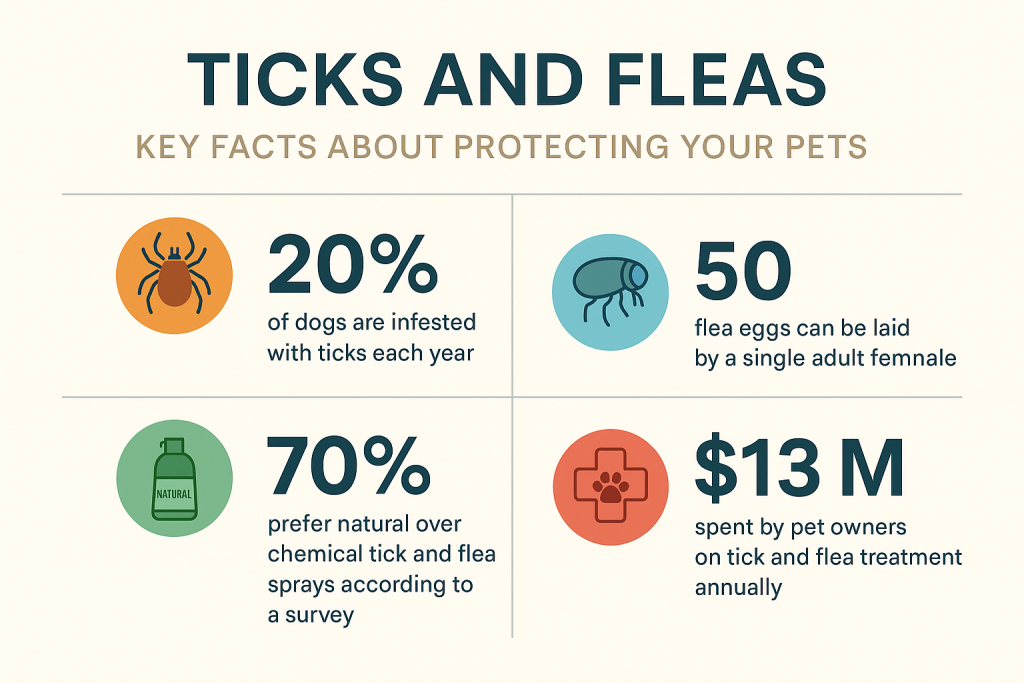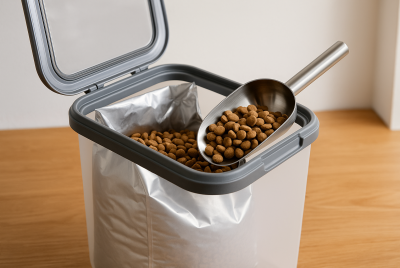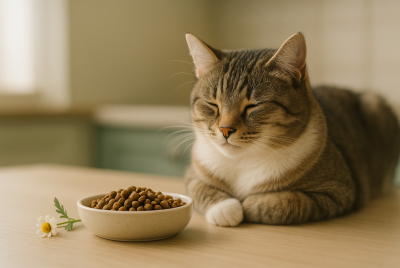5 Natural Tick and Flea Repellant Sprays You Can Safely Use
We may earn a commission for purchases made using our links. Please see our disclosure for more details.
If you’ve ever watched your dog do that frantic back-leg scratch or seen your cat abruptly bolt mid-nap, you know the “ugh—fleas?” moment. It’s stressful. And if you’re trying to avoid harsh chemicals around kids, carpets, or a cuddle-loving pet, it can feel like there’s no safe middle ground. That’s where natural tick and flea repellant sprays come in—simple, plant-based formulas that help you protect your pet and your home without turning your living room into a lab experiment.
In this friendly guide, we’ll walk through exactly what “natural” means, the ingredients to look for (and a few to rethink), and five trustworthy sprays you can grab on Amazon. You’ll also get a quick routine, a side-by-side comparison table, research summaries, and practical FAQs—so you can feel confident, not overwhelmed.
Why Go Natural with Tick and Flea Repellants?
Think of natural repellants as the home-cooked meal of pest control—fewer mystery ingredients, more you-can-pronounce plants. For many families, that means less worry about skin irritation, residue on sofas, and curious toddlers touching everything. Natural options may need more frequent reapplication than synthetics, but for a lot of pet parents, the tradeoff feels worth it.
What “Natural” Actually Means (and What It Doesn’t)
“Natural” typically refers to active ingredients derived from plants (e.g., cedarwood, lemongrass, peppermint, clove). It doesn’t mean “use without reading labels.” Cats, for example, are sensitive to some essential oils, and puppies or kittens under 12 weeks often have special directions. Always check age guidelines and species safety before you spray.
Safety First: How to Patch-Test on Your Pet
Before going all-in, spray a small amount on your pet’s shoulder blade area or a bandana/collar. Wait 24 hours. Watch for redness, excessive scratching, or lethargy. If everything’s calm, proceed per the label. (And when in doubt—text your vet a photo. Quick peace of mind.)
Key Plant-Based Ingredients That Repel Pests
- Cedarwood oil: Longtime favorite for repelling fleas and ticks around people, pets, and yards.
- Lemongrass oil: Fresh scent, widely used in natural “bug off” blends.
- Peppermint & rosemary oils: Crisp smell many pests dislike.
- Clove oil (eugenol): Common in plant-based pet sprays for contact-kill and repellency.
- Skip the myths: Apple cider vinegar doesn’t kill fleas; any benefit is more about smell than proven efficacy, and it can irritate skin if misused.
How to Use Natural Sprays for Best Results
- Pre-brush: Loosen dander and debris so spray reaches skin and coat.
- Light, even mist: Don’t soak. Focus on legs, belly, tail base, and neck (avoid eyes/nose/mouth).
- Reapply as directed: Natural products generally need more frequent touch-ups, especially after swimming or baths.
- Wash bedding weekly: Heat helps disrupt the flea life cycle.

Indoor + Outdoor Strategy (Yard, Bedding, Car)
Think layers: treat the pet, freshen bedding/soft surfaces, vacuum high-traffic zones (under sofas, along baseboards), and do a quick yard pass where your pet lounges. Car seats and cargo liners deserve a spritz too—hitchhikers happen after park days.
Product Picks at a Glance
These five Amazon best-sellers balance plant-based ingredients with real-world reviews. Details below, but here’s the vibe: two are budget-friendly, one is extra eco-forward, all are easy to use, and each has a scent profile you’ll either love (spa day) or pass on (too herb-y).
Wondercide Flea, Tick & Mosquito Spray for Dogs, Cats & Home
Why people love it: Multi-purpose, pet + home, cedar-forward scent that feels “clean yard after rain.”
Active approach: Essential oils (not harsh conventional pesticides).
Best for: Households that want a single bottle for both fur and furniture.
Features
- Plant-powered formula (cedarwood/lemongrass options)
- Safe for dogs and cats when used as directed
- Can be applied to pet bedding, rugs, and upholstery
Pros
- Versatile: pet + home
- Kid- and family-friendly positioning
- Multiple scents/sizes
Cons
- Needs more frequent reapplication than synthetics
- Scent preference is personal
Use Cases
- Daily summer walks, park trips, and porch lounging
- Weekly bedding refresh to discourage hitchhikers
What Reviewers Say)
Many mention fast relief and a pleasant smell; some note they reapply more often during peak season.
Vet’s Best Flea and Tick Home Spray for Dogs
Why people love it: Vet-developed plant-based formula; “clean house” feel without the chemical cloud.
Active approach: Peppermint oil & eugenol (from clove).
Best for: Indoor spraying—carpets, dog beds, couch zones.
Features
- Kills fleas, flea eggs, and ticks on contact
- For use around the home and on dogs (as labeled)
- Certified natural oils
Pros
- Recognized brand with veterinary roots
- Good value for multi-room coverage
- Fresh, minty aroma
Cons
- Some find the clove/peppermint strong at first
- Cat use varies—follow label precisely
Use Cases
- Post-vacuum spritz on baseboards and soft surfaces
- Before guests arrive (freshen, then crack a window)
What Reviewers Say
Praise for quick knock-down on contact; comments note the scent dissipates after a short airing out.

TropiClean Natural Maximum Strength Flea & Tick Home Spray
Why people love it: “Tropical clean” smell with lemongrass forward notes; easy to apply on bedding/furniture.
Active approach: Essential oil blend (e.g., lemongrass).
Best for: Families who like a brighter citrus profile and want simple whole-home use.
Features
- For carpets, upholstery, pet areas
- Plant-based active ingredients
- Designed to kill by contact (per product page)
Pros
- Light, fresh scent many describe as “clean”
- Quick home coverage with trigger sprayer
- Complements yard care routines
Cons
- Some pets dislike citrus aromas
- Check cat directions carefully
Use Cases
- Weekly bedding refresh + crate pads
- Car seat blankets after beach or trail days
What Reviewers Say
Often called “easy to use,” with users layering it into a broader routine (vacuum + laundry).
Natural Care Flea and Tick Home Spray for Dogs & Cats
Why people love it: Budget-friendly, big-room coverage; peppermint/clove duo for contact-kill + repellency.
Active approach: Plant-based oils including peppermint and eugenol (clove).
Best for: Multi-pet homes seeking an affordable, repeatable routine.
Features
- For dogs and cats 12+ weeks (per label)
- For use on pet areas, carpets, and flooring
- Contact-kill claim on fleas/ticks
Pros
- Great price point for larger spaces
- Easy to find and reorder
- Familiar scent profile
Cons
- More frequent reapplication in peak season
- Scent can be strong to sensitive noses
Use Cases
- Apartment dwellers refreshing high-traffic spots
- Budget-minded households treating multiple rooms
What Reviewers Say
Frequently praised as “works fast for the cost,” with reminders to follow up regularly.
Cedarcide Original Bug Spray (People, Pets & Home)
Why people love it: Cedar-rich, eco-forward choice that covers people, pets, and patios in one bottle.
Active approach: Natural cedar oil.
Best for: Households that want one product for yard hangs, hikes, and pet bedding.
Features
- For people, pets, and home use (per label)
- Repels fleas, ticks, mosquitoes, chiggers, ants
- Non-staining, made in the USA
Pros
- Simple ingredient story
- Broad “household” applicability
- Distinct cedar aroma
Cons
- Higher price than some competitors
- Cedar scent preference varies
Use Cases
- Porch season, backyard BBQs, soccer sidelines
- Quick pre-walk spritz on you and your dog
What Reviewers Say
Fans love the cedar smell and “all-in-one” versatility; some note they reapply on sweaty, humid days.
Side-by-Side Comparison
| Product | Plant-Based Actives | For | Scent Profile | Typical Use | Watch-outs |
| Wondercide Flea, Tick & Mosquito (Pets + Home) | Cedarwood, Lemongrass (variant dependent) | Dogs, cats, home | Fresh cedar/citrus | Daily spritz + bedding refresh | Reapply more often in peak season |
| Vet’s Best Flea & Tick Home Spray | Peppermint, Eugenol (clove) | Home + dogs | Minty, clove-spice | Carpets, dog beds, baseboards | Strong initial scent for some |
| TropiClean Natural Home Spray | Lemongrass blend | Home (dogs/cats per label) | Clean citrus | Furniture, crates, rugs | Some pets dislike citrus |
| Natural Care Flea & Tick | Peppermint, Eugenol (clove) | Dogs/cats 12+ weeks + home | Classic herbal/minty | Budget whole-home routine | Frequent reapply |
| Cedarcide Original | Cedar oil | People, pets, home | Cedarwood | All-purpose porch/yard + pet | Price and distinct cedar scent |

Real-Life Routine: A 5-Minute Weekly Plan
- Mondays: Wash pet bedding on hot; quick spritz after drying.
- Wednesdays: Vacuum baseboards, sofa crevices, under beds; light home spray afterward.
- Fridays: Pre-walk spritz on your dog (avoid face); wipe paws on return.
- Weekends: Quick porch/yard perimeter treatment (or use a people-safe spray on you + leash handle).
This rhythm keeps things consistent without feeling like a second job.
Research-Backed Insights: What the Science Says
1) Variability among “minimum risk” botanical products against ticks
A perspective article in Emerging Infectious Diseases (CDC) found that some cedarwood-based “minimum risk” repellents showed only 5–24% effectiveness against blacklegged ticks. The authors caution that not all natural tick repellents deliver consistent protection.
Read more: Efficacy of Unregulated Minimum Risk Products to Kill and Repel Ticks (CDC)
2) Essential oils show acaricidal + repellent potential
A review in Parasites & Vectors concluded that essential oils like clove, thyme, and cedarwood often demonstrate strong acaricidal (tick-killing) and repellent properties. However, results vary depending on formulation and concentration.
Read more: Essential oils and their acaricidal activity: a review
FAQs
1) Do natural tick and flea repellant sprays really work?
They can—especially when used consistently and as part of a layered routine (pet + bedding + floors + yard). Expect to reapply more often than with synthetic pesticides, particularly after baths or swims.
2) Can I use these sprays on cats as well as dogs?
Some products are labeled for both, others specify dogs only. Cats can be allergic to some oils. Always read the label by species and age (kittens/puppies under 12 weeks usually have restrictions).
3) How often should I reapply a plant-based spray?
Follow the bottle, but many pet parents reapply every 1–3 days during peak season or after water exposure. Frequency is a tradeoff for avoiding stronger chemicals.
4) Will natural sprays protect my home, or just my pet?
Both—several picks here are designed for home surfaces + pet use. Layer with laundry and vacuuming to break the flea life cycle faster.
5) Can I combine a natural spray with my vet-prescribed prevention?
Often, yes—but ask your vet if you use oral/topical preventatives. Many families use a vet-approved baseline and add natural sprays for daily outings or between doses.
Helpful Resource
Keeping the feeding area tidy helps you spot signs of skin flakes or flea dirt early. Consider a non-slip, easy-to-clean pet food mat to contain crumbs and drips (and make quick wipe-downs painless). Here’s a handy guide: best pet food mat tips and picks.
Conclusion
If you’re leaning natural, you’re not alone. With the right plan and the right products, you can protect your fur family without fogging your house in harsh chemicals. Start simple: pick one of the five plant-powered sprays above, set a quick weekly routine, and stay consistent through the warm months. You’ll notice less scratching, calmer cuddle time, and a home that smells like a fresh spa day—not a chemistry set.
And remember: perfection isn’t the goal—steady, kind care is. You’ve got this. 🌿🐾




